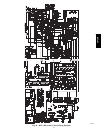
24
On 50TCQ units equipped with factory--installed Smoke
Detector(s), the smoke detector controller implements the
unit shutdown through it s NC contact set connected t o the
unit’s CTB input. The FSD function is initiated via the
smoke detector’s Alarm NO contact set. The PremierLink
communicates the smoke detector’s tripped status to the
CCN building control. See Fig. 30, the PremierLink
wiring schematic.
Filter Status Switch — This function is available only
when PremierLink is configured for (Space) Sensor Mode.
PremierLink control can monitor return filter status in two
ways: By monitoring a field--supplied/installed filter
pressure switch or via supply fan runtime hours.
Using switch input: Install the dirty filter pressure switch
according to switch manufacturer ’s instructions, to
measure pressure drop across the unit’s return filters.
Connect one side of the switch’s NO contact set to CTB’s
THERMOSTAT--R terminal. Connect the other side of the
NO contact set to TB1--10. Setpoint for Dirty Filter is set
at the switch. See Fig. 42.
R
TB1
J4-4
PL
Filter Switch (NO, close on rising pressure (high drop))
CTB
Thermostat
10
C08216
Fig. 42 -- PremierLink Filter Switch Connection
When the filter switch’s NO contact set closes as filter
pressure drop increases (indicating dirt--laden filters), the
input signal to PremierLink causes the filter status point to
read “DIRTY”.
Using Filter Timer Hours: Refer to Form 33CS-- 58SI for
instructions on using the PremierLi nk Configuration
screens and on unit alarm sequence.
Supply Fan Status Switch — The PremierLink cont rol can
monitor supply fan operation through a
field--supplied/installed differential pressure switch. This
sequence will prevent (or interrupt) opera tion of unit
cooling, heating and economizer functions until the
pressure switch contacts are closed indicating proper
supply fan operation.
Install the differential pressure switch in the supply fan
section according to switch manufacturer’s instructions.
Arrange the switch c ontact to be open on no flow and to
close as pressure rises indicating fan operation.
Connect one side of the switch’s NO contact set to CTB’s
THERMOSTAT--R terminal. Connect the other side of the
NO contact set t o TB1--8. Setpoint for Supply Fan Status
is set at the switch. See Fig. 43.
R
8
TB1
J4-6
PL
Fan (Pressure) Switch (NO, close on rise in pressure)
CTB
Thermostat
C08118
Fig. 43 -- PremierLink Wiring Fan Pressure Switch
Connection
Remote Occupied Switch — The PremierLink control
permits a remote timeclock to override the control’s
on--board occupancy schedule and place the unit into
Occupie d mode. This function may also provide a “Door
Switch” time delay function that will terminate cooling
and heating functions after a 2--20 minute delay.
Connect one side of the NO contact set on the timeclock
to CTB’s THERMOSTAT-- R terminal. Connect the other
side of the timeclock contact to the unit’s TB1--2 terminal.
R
2
TB1
PL
Time Clock
Remote Occupied
CTB
Thermostat
J4-12
C08214
Fig. 44 -- PremierLink Wiring Remote Occupied
Refer to Form 33CS--58SI for additional information on
configuring the PremierLink control for Door Switch
timer function.
Power Exhaust (output) -- Connect the accessory Power
Exhaust contactor coils(s) per Fig. 45.
Space Relative Humidity Sensor — The RH sensor is not
used with 50TCQ models at this time.
J8-3
15
C
TB1
PL
PEC
TAN
GRA
Power Exhaust
CTB
THERMOSTAT
C08120
Fig. 4 5 -- PremierLink Power Exhaust Output
Connection
CCN Communication Bus — The PremierLink controller
connec ts to the bus in a dai sy chain arrangement.
Negative pins on each component must be connected to
respective negative pins, and likewise, positive pins on
each component must be connected to respective positive
pins. The c ontroller signal pins must be wired to the signal
ground pins. Wiring connections for CCN m ust be made
at the 3--pin plug.
50TCQA


















